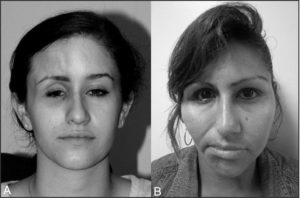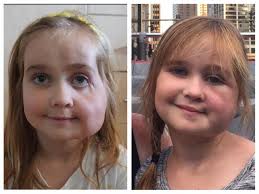Parry-Romberg syndrome is a rare disorder characterized by slowly progressive deterioration (atrophy) of the skin and soft tissues of half of the face (hemifacial atrophy), usually the left side. It is more common in females than in males. Initial facial changes usually involve the tissues above the upper jaw (maxilla) or between the nose and the upper corner of the lip (nasolabial fold) and subsequently progress to the angle of the mouth, areas around the eye, the brow, the ear, and the neck. The deterioration may also affect the tongue, the soft and fleshy part of the roof of the mouth, and the gums. The eye and cheek of the affected side may become sunken and facial hair may turn white and fall out (alopecia). In addition, the skin overlying affected areas may become darkly pigmented (hyperpigmentation) with, in some cases, areas of hyperpigmentation and patches of unpigmented skin (vitiligo). Parry-Romberg syndrome is also accompanied by neurological abnormalities including seizures and episodes of severe facial pain (trigeminal neuralgia). Cranial neuropathies involving cranial nerves III, V, VI, and VII, have also been described in patients with PHA. Secondary trigeminal neuralgia has been reported due to impingement of the nerve by destruction of bony structures, as well as vascular inflammation and damage resulting in facial pain that can be chronic and poorly responsive to treatment. Additionally, speech may be affected in PHA patients resulting in dysarthria or aphasia. Cognitive impairment and an increase in behavioral disorders have also been noted. Depending on the degree of atrophy, changes to intracranial tissue and vessels may also result in hemiparesis, dysesthesias, and paresthesias.
The onset of the disease usually begins between the ages of 5 and 15 years. The progression of the atrophy often lasts from 2 to 10 years, and then the process seems to enter a stable phase. Muscles in the face may atrophy and there may be bone loss in the facial bones. Problems with the retina and optic nerve may occur when the disease surrounds the eye.
The prognosis for individuals with Parry-Romberg syndrome varies. In some cases, the atrophy ends before the entire face is affected. In mild cases, the disorder usually causes no disability other than cosmetic effects.
Unfortunately there is no cure and there are no treatments that can stop the progression of Parry-Romberg syndrome. Reconstructive or microvascular surgery may be needed to repair wasted tissue. The timing of surgical intervention is generally agreed to be the best following exhaustion of the disease course and completion of facial growth. Most surgeons will recommend a waiting period of one or two years before proceeding with reconstruction. Muscle or bone grafts may also be helpful. Other treatment is symptomatic and supportive.


